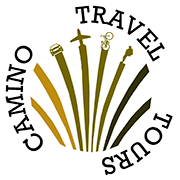Camino de Santiago from Saint-Jean-Pied-de-Port

Camino de Santiago from Saint-Jean-Pied-de-Port a Pie
Know our itinerary
We start our road in Saint-Jean pied-de-Port, a medieval town where pilgrimage routes to Santiago from all across Europe converge. This first stage goes through the Pyrenees and is quite challenging, so we advise you to be well prepared.
We can choose between two routes: the so-called “Napoleon route”, which climbs up to 1400 m. and passes through Orisson and Honto, and the Valcarlos route, slightly easier, specially during bad weather (in fact, it is mandatory during the winter). If you’d like to walk on a more relaxed pace, you can split this stage in two and spend the night in Orisson (Napoleon route) or Valcarlos.
We begin this stage in Roncesvalles, where the legendary battle between Charlemagne’s army and the basques took place. We can visit the Santa María collegiate and the Espíritu Santo chapel, built according to legend to bury the frank knights who fell on the battle.
The road to Zubiri goes through mountains and forests, with two challenging climbs in the Alto de Mezquiriz and the Alto de Erro. After the latter, a steep descent takes us to our destination.
We start the stage crossing the medieval bridge in Zubiri, known as the “rabies bridge”, because villagers used to take their animals to walk three times around its central pylon to cure them of said disease.
The Camino follows during this stage the course of the Arga river. In Akerreta we’ll be able to see its rural hotel, which was featured in the movie “The Way”. We’ll also cross Villava, hometown of the famous cyclist Miguel Indurain.
Pamplona is the first big city that we’ll find in the Camino, and it’s mostly known for its bull running (on July 7th), but it also features lots of attractions to explore: food, cafés, the cathedral, the Castillo Square…
Know our itinerary
We start our road in Saint-Jean pied-de-Port, a medieval town where pilgrimage routes to Santiago from all across Europe converge. This first stage goes through the Pyrenees and is quite challenging, so we advise you to be well prepared.
We can choose between two routes: the so-called “Napoleon route”, which climbs up to 1400 m. and passes through Orisson and Honto, and the Valcarlos route, slightly easier, specially during bad weather (in fact, it is mandatory during the winter). If you’d like to walk on a more relaxed pace, you can split this stage in two and spend the night in Orisson (Napoleon route) or Valcarlos.
We begin this stage in Roncesvalles, where the legendary battle between Charlemagne’s army and the basques took place. We can visit the Santa María collegiate and the Espíritu Santo chapel, built according to legend to bury the frank knights who fell on the battle.
The road to Zubiri goes through mountains and forests, with two challenging climbs in the Alto de Mezquiriz and the Alto de Erro. After the latter, a steep descent takes us to our destination.
We start the stage crossing the medieval bridge in Zubiri, known as the “rabies bridge”, because villagers used to take their animals to walk three times around its central pylon to cure them of said disease.
The Camino follows during this stage the course of the Arga river. In Akerreta we’ll be able to see its rural hotel, which was featured in the movie “The Way”. We’ll also cross Villava, hometown of the famous cyclist Miguel Indurain.
Pamplona is the first big city that we’ll find in the Camino, and it’s mostly known for its bull running (on July 7th), but it also features lots of attractions to explore: food, cafés, the cathedral, the Castillo Square…
All our packs include
- Accommodation
- Breakfast
- Luggage transfer
- Travel insurance
- Telephone assistance
- Credential and travel notebook
All our packs include
- Accommodation
- Breakfast
- Luggage transfer
- Travel insurance
- Telephone assistance
- Credential and travel notebook
Accommodation options
Hostels
Accommodation in private hostels, selected by our team for its quality and comfort.
From 195€
Pensions
Accommodation in pensions, hostels and charming cottages.
Private rooms with their own bathroom and all the necessary services.
From 355€ *
Premium
Accommodation in hotels with 4 stars or more.
In places where they are not available, the accommodation will be in the best category hotel in the area.
From 555€ *
* Prices conditioned to individual supplement
Accommodation options
Hostels
Accommodation in private hostels, selected by our team for its quality and comfort.
From 195€
Pensions
Accommodation in pensions, hostels and charming cottages.
Private rooms with their own bathroom and all the necessary services.
From 355€ *
Premium
Accommodation in hotels with 4 stars or more.
In places where they are not available, the accommodation will be in the best category hotel in the area.
From 555€ *
* Prices conditioned to individual supplement




